Time-of-Flight Guru
 |
| The Sample Gates at the formal entrance to Indiana University in Bloomington, IN. 5 Aug 2022. |
It is not always easy to recognize a transformative experience while it is happening, but in hindsight I cannot describe it any other way.
 |
| My homebuilt matrix-assisted laser desorption / ionization time-of-flight mass spectrometer photographed circa 1999 while it was in active use. |
Jim granted and encouraged independence, but was nearly always available for consultation when needed. Under Jim’s mentorship, I learned to problem solve and clearly communicate complex scientific ideas. “People are stupid, beat them over the head,” he would say as I toiled away on a manuscript. It may sound harsh, but was actually a good reminder to lay things out for people and lead them down a path without making undue assumptions about their existing knowledge or ability to follow logical leaps.
 |
| Presenting a poster on my work to trap and directly observe phosphatase enzyme intermediates at the 1998 American Society for Mass Spectrometry (ASMS) conference in Orlando, FL. Photo by Jon. |
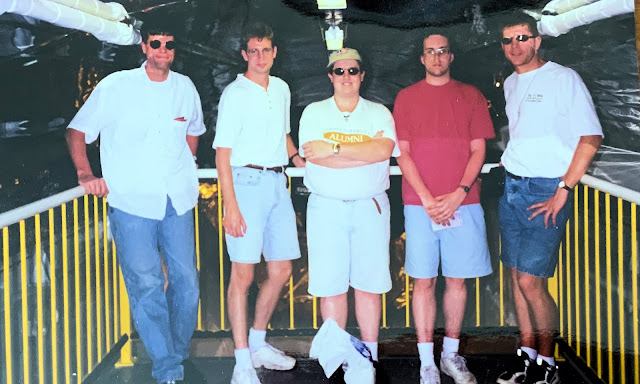 |
| The Reilly Group at Kennedy Space Center while in Florida for the 1998 ASMS conference: Noah, me, Jon, Bill, and Randy. |
 |
| Jim Reilly (credit: IU) |
We lost Jim on February 13, 2022 after a brief battle with cancer. While I did not always see eye to eye with my former doctoral advisor, I can say without hesitation that I would not be the scientist that I am today without his influence.
Belated Visitation
Vacation in Wisconsin placed me closer to Bloomington, IN than I had been in a very long time, so I decided to make a day trip to Indiana University to reconnect with former officemate Jon, now serving as Assistant Chair in the Chemistry Department. The unenviable task of excavating Jim's stereotypically cluttered office and sorting through what our advisor left behind had fallen to Jon. When it was finished, he reached out to say that he rescued some items of interest to me. It seemed a good time to reconnect, to reflect on Jim's passing, and to visit the lab one last time before it was emptied of its treasures and bequeathed to a different faculty member.
| Date | Aircraft | Route of Flight | Time (hrs) | Total (hrs) |
| 05 Aug 2022 | N21481 | Y51 (Viroqua, WI) - BMG (Bloomington, IN) - Y51 | 6.1 | 2502.0 |
That morning, I rose at 5:30 am, was out of the house by 6:00 am, and on the ramp at Viroqua Municipal by 6:30 am. I was targeting an 11:00 am arrival at the Monroe County Airport in Bloomington, IN and would lose an hour crossing back into the Eastern Daylight time zone during the three hour flight.
The many valleys I traversed on the ground that morning were choked with fog and, as the windshield began to condense moisture, I struggled to locate the Dodge's windshield wiper control. I may have directed some coarse language at the minivan designers in that moment, but the Dodge was a coarse vehicle and I am sure that there were no hard feelings.
Because Viroqua Municipal sits at a slightly higher elevation than the surrounding area, it was mercifully free of fog when I arrived. But not to worry, there would be opportunity for a low visibility instrument departure from Viroqua yet.
I topped off the airplane's fuel, noting that the fuel pump surged slightly as I squeezed the last few gallons into the Warrior's tanks.
Just a few minutes after 7:00 am and more or less on time, I was airborne and cleared on an instrument flight plan to Bloomington by Minneapolis Center.
Below, dense fog still clung to certain valleys. The Kickapoo River was a nexus for fog that highlighted its winding path to the southwest where it joined a denser mass of vapor floating over the more substantial Wisconsin River.
 |
| Crossing the fog-shrouded Wisconsin River. |
Naturally, a flight over the Driftless Region would be incomplete without observing some interesting crop art.
Over Illinois, I reached a solid undercast that would obscure my view of the ground until the descent into Bloomington.
Hoosier Buddy?
Crossing the border into Indiana, I recalled that one of the first articles I read in the Bloomington newspaper in 1994 pondered the origins of the word "Hoosier". After describing several possible etymologies, the author concluded that we would never really know for sure and the mystery remained unsolved.
Eventually, I was handed off to Hulman Approach in Terre Haute, IN, which I assume was named for the same Hulman family that was an early benefactor of the Rose-Hulman Institute of Technology.
Hulman Approach cleared me direct to ZESXY, an initial approach fix for the RNAV 17 approach into Bloomington. Along the way, I navigated a number of misty canyons of cumulus floating over the rolling hills of southern Indiana.
I broke out before reaching the final approach fix at OGUSY, so despite flying a portion of an instrument approach, I was unable to log it.
 |
| Short final for runway 17 in Bloomington, IN. |
Finding My Way
I parked at the Cook Aviation FBO and requested a top-off at $6.70/gal, which was actually much cheaper than the $7.40/gal advertised by the on-field competition. Securing one of the FBO's Cadillac SUV courtesy cars required a promise to return by 3:00, which meant that my visit would be on a clock.
 |
| Me and Kristy at our weird little house in 1997. Photo by Lisa. |
I found my way back to the weird little house on 8th street where Kristy and I lived for the last 3+ years of our time in Bloomington. I wondered what had become of the weird little landlord of that weird little house. I think this was my first time seeing the place since I left town in 1999. I tried to take a picture from the car to share with Kristy, but succeeded only in capturing a pink blur of index finger instead. Not to worry, the house looked the same as it did when we lived there.
En route to the University, I was pleased to verify the continued existence of local bars Irish Lion and Crazy Horse. It was also nice to see the courthouse square again. Our house was a two mile walk from the lab and I used to stroll briskly through the center of town at least twice every day.
Back among the limestone edifices of IU's wooded campus, I was reminded of how beautiful the place was. Back when I was spending 15+ hours a day in the lab, I often took midafternoon walks through campus to clear my head, always with a deep appreciation for the architecture around me.
I entered the Chemistry Building through the impressive "tower" entrance that was more a less a back door to the building.
The small courtyard formed by the intersections of the 1930s portion of the building (center), the 1960s tower (left) and the 1980s addition (the glass atrium at right) was missing the large tree that once grew there. The second window up on the far left belonged to my former office.
While it might seem that a Chemistry Building would have a "chemical" odor to it, that was rarely the case. But it did have a unique aroma and, as soon as I stepped through the door, the first whiff transported me back 20+ years in time. It smelled exactly the same.
I found Jon's office in the administrative suite where he introduced me to a visiting professor that had been a student in the department sometime after I graduated. He was there to visit his former advisor, Gary Hieftje, who happened to be in the building clearing out his office in preparation for retirement.
"Oh, I've heard your name before," the visitor said, shaking my hand. Really? I cannot fathom how.
"Chris was my mentor," Jon explained. "He taught me everything I know and was very patient with me."
"Jon, I was not patient with you," I countered bluntly. The truth was that he had frustrated me many times during our three years of sharing an office; my list of grievances was long. Despite a rocky history, I have seen him grow into a thoughtful adult and scientist who thinks deeply and has great empathy for others. Today, I am glad to call him my friend.
Jon's four word reply, which I will not reproduce here, was one of the briefest statements of self-aware contrition that I have ever heard anyone make.
Then again, we've all come a long way since our time as young, self-absorbed proto-scientists.
Last Visit To the Reilly Lab
"Where are all the test tubes?" my grandmother quipped on her first visit to the Reilly Lab decades ago. The lab always felt a bit more like a mad scientist's garage than a proper chemistry lab, but most of us liked it that way.
I stood before the mass spectrometer whose design and construction I led about 25 years ago. Though its use outlasted my tenure in the lab, it was decommissioned sometime during the previous decade. I published multiple papers from data generated on this system and was depressed to witness its current condition. The old military surplus diffusion pump was cold, the mechanical vacuum pumps silent, and no glow came from the filament of the ion gauge. Various labels on the instrument were brittle and faded, though my handwriting was still distinctly recognizable on many of them. Something had spattered across the vacuum chamber from above, leaving behind a dried residue that I would not have tolerated during the instrument's time of generating viable ion beams.
A pile of stainless steel sample probes and their electrically isolating glass handles lay beneath the system. Jon thoughtfully scavenged a pair of the stainless steel probes for me to take home; I had designed them sometime during the mid 1990s.
In my final year, I was doing an experiment that used a nitrogen laser (337 nm) to send sample molecules flying through the instrument to be intercepted and ionized by a pulsed XeCl excimer laser (308 nm) timed to fire at just the right moment. The nitrogen laser was pumped by a spark gap electrical discharge that made it sound suspiciously like motorboat while it operated. I was surprised to discover it trapped beneath other equipment, forgotten.
As Jon and I explored the largely abandoned lab, reminiscing about people and events, we found some components that were once critical to the performance of our instrumentation. Granville ion gauge controllers dutifully monitored the high vacuum regions of our instruments. To the right of them were a pair of Stanford Research Systems power supplies used to reliably float a few kilovolts wherever needed. They were doppelgangers of the Stanford DG-535 digital delay generators that served as nanosecond precision pacemakers for our homebuilt spectrometers.
Components from a disassembled vacuum chamber occupied the shelves and appeared to be all that was left of the original instrument that I used during the first year. It was the one supported by a wooden scaffold that when leaned upon properly, would twist the chamber relative to the laser optics just enough to raster the beam across samples. It was a crude but shockingly effective way of fine tuning ion signal intensity. My early weeks in the lab were spent maximizing the signal produced by single stranded DNA oligomer ions on a live oscilloscope screen driven by a Biomation waveform recorder. As neophytes, senior group member Steve would verbally flog us, entreating us to "lean harder" in the quest for better signal.
Incidentally, leaning was not a technique that was useful or necessary once I completed the successor to that instrument.
When I was a student, we connected with a scientist at Eli Lilly who generously donated surplus analytical equipment to our cause. One instrument was a Finnigan TSQ-700, an early electrospray ionization triple quadrupole mass spectrometer. Jim was reticent to accept the donation, but I ultimately convinced him that it would complement our existing capabilities. Jon became the primary user of the system and ultimately published useful data from it. To our chagrin, all that was left of the system was a portion of the vacuum chamber containing the rail for the ion optics.
I wondered if an inspection of the refrigerator would turn up anything left over from my time in the lab, but decided I would rather not know.
The odd black and white photo of goggled researchers stuck on the glassware drying rack was placed there by students from before my time. I was astounded that it was still present.
I also remembered the day I nearly lost an eye when some older students were playing with sodium metal and water in the sink. An innocent bystander, I caught a bit of searing hot shrapnel just below my right eye. Perhaps that picture of the guys with goggles was more warning than whimsy.
One thing that I did know for certain was that the clutter around the eyewash station would have made the safety team at work go apoplectic.
I would never suggest that Jim took our safety lightly. But our safety briefing upon entry to the lab was minimal and direct. It primarily consisted of two points:
1. Don't touch the high voltage.
2. Don't look into the laser beam.
There was a general laboratory rule to keep all laser beams at table level. This was a good rule. Jim augmented these basic safety rules with an article taped to the laboratory door, a rather graphic description of what happened to a researcher struck in the eye by a stray beam from a Nd:YAG laser. Incidentally, this was the same type of laser that we used for most of our experiments. (Albeit in a frequency tripled mode to convert the 1064 nm fundamental to 355 nm, but I digress.) Placing a piece of nice, high quality cotton paper (dollar bills worked also) in front of the beam would create a snapping sound as the beam's energy incinerated individual cellulosic fibers.
Jon explained that the lab needed to be cleaned out by November to accommodate new faculty. There are a number of scientists out in the world with histories tied intimately to this laboratory, where so much hard work and time investment and problem solving and frustration and triumph occurred. It saddens me to know that it will soon cease to exist.
Although Jim was never a stranger to the lab, most of the time I worked alone or with other students. Nonetheless, his presence was undeniable. Where some might perceive random clutter, I saw a curated collection of artifacts that had each inspired Jim to try an experiment. So many experiments! So many opportunities to "see what develops". Standing there, I could have almost imagined that Jim was just around the corner in his former office, ready to offer guidance when needed. It was difficult to accept that he was truly gone.
 |
| Lindley Hall with Kirkwood Hall in the distance. |
After our laboratory tour, Jon and I visited a few other places within the department before venturing to 4th Street for lunch at Siam House. As a new graduate student in 1994, the restaurants just beyond the campus gate were a wonder; most of them old houses converted into eateries featuring Indian, Thai, Tibetan, and Mediterranean cuisine. It was all novel to me and my culinary palette blossomed there. Siam House was my first exposure to Thai food and lunch there was a delicious homecoming.
After lunch, with my 3:00 deadline to return the car rapidly approaching, Jon and I diverted through the official entrance to campus so that I could capture a postcard photo.
 |
| Jon and me looking a little grayer than we used to. Photo by Jon. |
It was hot in Bloomington and I was melting.
Jon's care package for me consisted of Jim's copy of my bound dissertation, eight of my research notebooks (the ninth and final notebook appeared to be missing), and a pair of stainless steel probes that I had designed for my instrument.
There was also a folder of documents that included acceptance letters for some of my presentations at past American Society for Mass Spectrometry (ASMS) conferences. Acceptance for the poster depicted at the beginning of this post was one of them, work that eventually became the crown jewel of my dissertation.
Also in the folder were my original, hand-drawn sketches for most of the components of my instrument, including the pictured microchannel plate detector anode (the "Hershey's kiss") and outer waveguide assembly. It was a novel design inspired by a fellow named Wurz that was intended to provide optimal impedance matching for a detector with a compact copper anode. The complex curves of these pieces were beyond my skill to make. Thus, we provided this drawing to the department's professional machinists who fabricated them. These components are part of the detector that is still mounted to "my" instrument. Some of the drawings still bore spatters of machine oil for extra authenticity.
I am no draftsman, but I think this drawing compares favorably to that Stonehenge sketch from This Is Spinal Tap. Holding this old drawing in my hand again rendered me speechless. What a treasure.
Thanks, Jon.
And thanks to Jim for letting me do some really cool things on the path to becoming a scientist.
Rest in peace.
OK...Boomers
I returned the Caddy SUV to Cook Aviation at exactly 3:00 pm and performed a preflight while being pelted by raindrops. Isolated thunderstorms blemished the weather map around Bloomington, but appeared to be navigable and so I launched on an instrument clearance direct to Viroqua.
Fortunately, my course missed most of the storm cells and I requested deviations when I did not like the looks of buildups in my path.
With the day's heat finally relenting, many of the storms were already diminishing, their angular anvil heads losing definition and melting into wraiths.
A particularly savage storm had been raging over Chicago, but it was in the process of blowing itself out as I transited the area.
I passed what appeared to be an aerial garden growing cumulus clouds, they extended skyward, raised like little convection-fueled fists in the early evening.
The Wisconsin River was slightly more visible in the evening than it had been that morning.
Outta Gas
 |
| Final for runway 20 at Viroqua. I wondered if I freaked out any drivers on highway 14. |
I taxied to the fuel farm where I was met by another pair of pilots. "We couldn't get it to work," one said. "But I would be happy to stand here and watch you try." So I did. I managed to squeeze out all of $1.46 worth.
A local pilot approached and we explained what was happening, debating about whether the fuel pump was actually broken or simply out of gas. I described the surging behavior from that morning. "That's what it does when it's nearly out of fuel," the local pilot explained. "Our price was too low, people leaving Oshkosh (EAA AirVenture 2022) last week mostly cleaned us out."
Disappointed to be missing out on more $5.49/gal avgas, this meant that I would need to find someplace else for fuel before the long trip home.
I began scheming almost immediately.

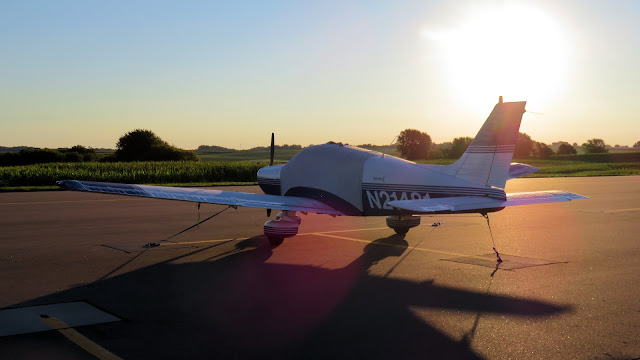







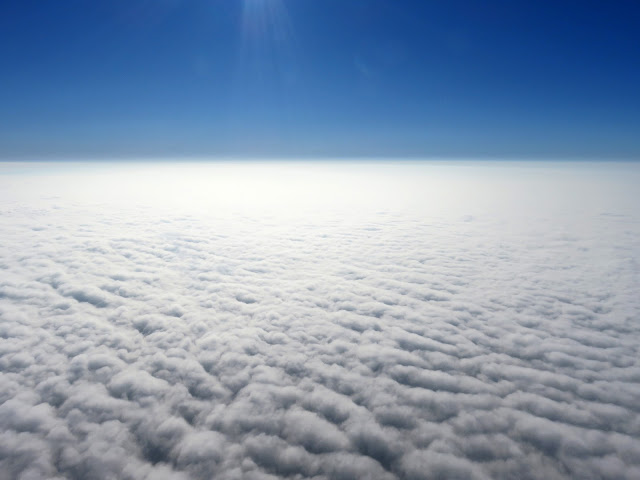












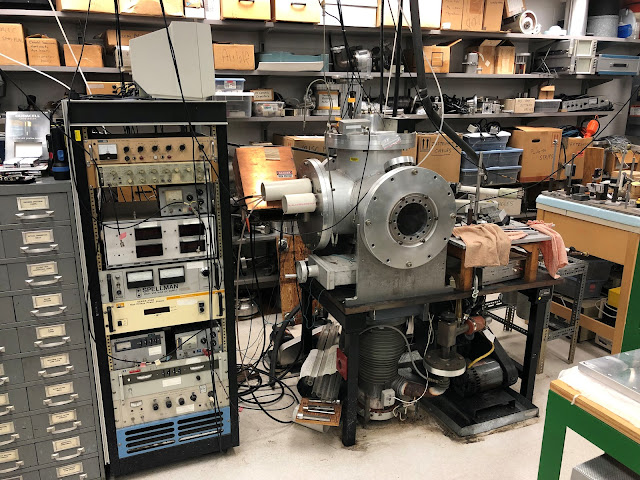













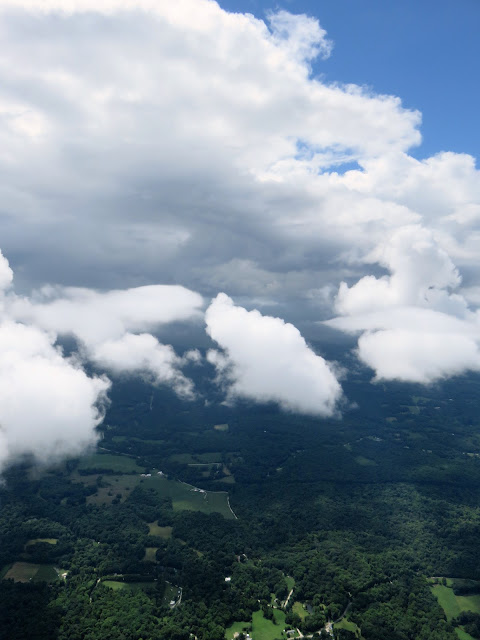










No comments:
Post a Comment